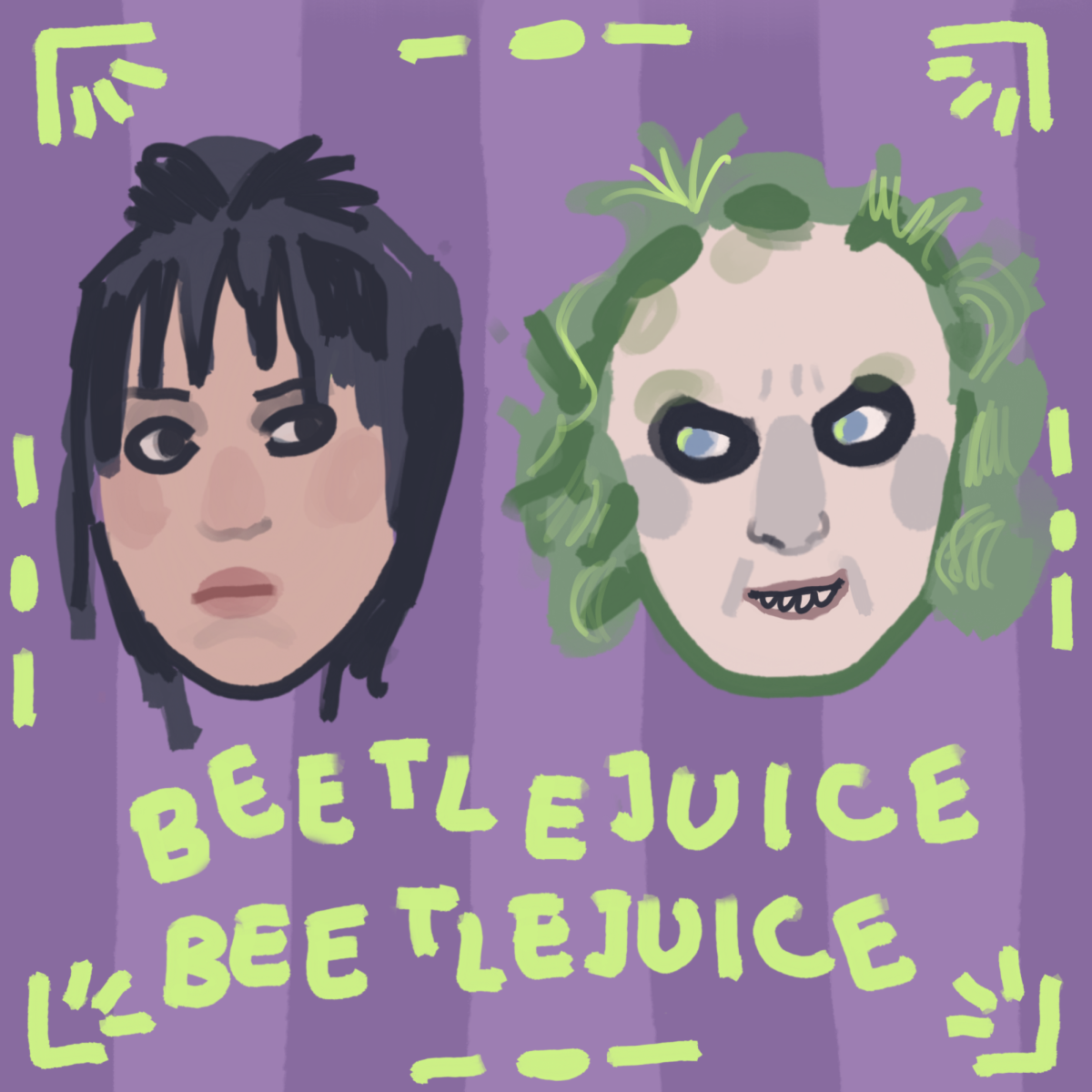*SPOILERS AHEAD*
On March 30, 1988, Tim Burton released his second feature film Beetlejuice. It was instantly a hit and is still a spooky movie staple to this day. The film did not end on any sort of cliffhanger, so it came as a surprise when this year on September 6, the sequel titled Beetlejuice Beetlejuice was released.
Many actors from the original cast returned to reprise their roles, including Winona Ryder (Lydia Deetz), Catherine O’ Hara (Delia Deetz), and Michael Keaton (Beetlejuice). The film is set around 36 years after the events of the original as Lydia tries to navigate her tenuous relationship with her daughter, Astrid (Jenna Ortega) and stars in her own ghost-themed TV show. Still haunted by memories of Beetlejuice, things get crazier for Lydia as Delia informs her that her father, Charles Deetz, has died. This is one of the few plotlines that this movie tries to follow.
One plotline leads Astrid to the underworld after accidentally trading souls with a ghost boy. Another features Beetlejuice’s cult leader ex-wife, Delores, escaping from her place in the underworld and trying to find him. Another features dead-actor-turned-ghost-cop Wolf Jackson trying to capture Delores. It seems as if the writers couldn’t agree on one central plotline, so they just crammed them all in the 104-minute film. While none of the storylines are uninteresting, it’s hard for audiences to feel attached to any of them when there’s no opportunity to dig deep into any of the plotlines.
Additionally, all these storylines jumbled together creates an unclear narrative of what happens when people go to the underworld. Some people die and take jobs in the underworld, some stay in the places they died forever, and others have to take the “Soul Train” to the great beyond. It’s never clarified why there are so many different places that dead people end up, which is something that could’ve been cleared up with a sequel. There’s also no guarantee there will be a third installment of Beetlejuice, which means it’s likely that a lot of these ponderings about the lore behind the underworld will go unanswered.
Aside from the underworld qualms, some of the offhand lines made by characters in the movie imply different outcomes than presented in the original movie. At one point Lydia was talking to Delia, and she mentioned that her real mother wasn’t dead. This comment isn’t addressed at any other point throughout the film. It also wouldn’t make sense in the broader context, since Lydia’s mom being dead is the whole reason for Deetz’s move in the first movie and why Lydia can see ghosts. It’s also never addressed when Lydia reconnects with her father and Delia, seeing as both of them were kicked out of the house at the end of the first movie and Lydia was seemingly being raised by the Maitlands. The audience is left to their own devices on how the characters got to the point from the end of the first movie.
The most confusing part of the movie is the ending. It’s a strange dream-like sequence where Astrid meets a boy, gets married, and gives birth to a grotesque baby Beetlejuice. This section of the movie came completely out of left field. Then, after the baby Beetlejuice is crawling around, Lydia wakes up and five seconds later the credits roll. There’s no post-credit scene or anything to clarify this abrupt ending. As mentioned earlier, there’s no confirmation of a third movie, leaving this mysterious course of events up to the interpretation of the audience who chose to watch this strange sequel.
Though the story itself is confusing, the film’s visuals keep their creepy, fun, Burton-esque integrity. There isn’t much CGI used though those types of special effects have become more prominent within the film industry the past 15 years. There is always something interesting to look at on the screen, including the many dead people in the underworld plagued by different forms of death or the giant desert sandworm.
The soundtrack does not feature any new compositions from Danny Elfman like the original and many other of Burton’s films. It uses a variation of different pre-existing songs, like “Right Here Waiting” by Richard Marx and “Tragedy” by the Bee Gees. These add a layer of comedy to the file because, as people keep entering the underworld, the scenes are underscored by catchy music.
Furthermore, the movie features a nearly eight-minute-long segment of Beetlejuice lip-syncing “MacArthur Park” by Richard Harris while he and Lydia are about to get married, accompanied by levitation in the church and Dafoe’s character and his crew coming to arrest Beetlejuice. There’s no other lead-up or clear logic to this scene. It’s another silly interjection that gives the audience a good laugh and another strange thing to think about on their drive home. That lip sync scene is a perfect example of what the movie felt like-jarring, ridiculous, and joyful. Beetlejuice Beetlejuice is the type of movie where you can assume that the people working on it had a blast. While it doesn’t make complete sense, every actor in this movie is completely committed to their characters. That dedication and joy of the movie-making process is part of the reason why this movie made $110 million dollars at the box offices in the US and Canada on its opening weekend.
Not all pieces of media need to be perfect in every aspect. A movie can have a bad plot and still be fun, just as a movie can have a good plot and still be boring. Is this movie confusing? Yes. Are there many plot holes that are not resolved? Yes. Is it still an enjoyable movie with interesting visuals that is super fun to watch? Yes.

